Argente Golden: A* CC D* E* pp Uw*
Argente (Golden) is one of the commonly-found ginger coat colors of the Mongolian gerbil. This color is created when a (Golden) Agouti gerbil inherits two Pink Eye genes. This gerbil color is a strong ginger coat from nose to tail, with pink eyes and a bright white tummy.
[Awaiting Image]
This color is one of three shades of ginger-colored gerbils available – and uses two of the most common gerbil colour genes – Agouti and Pink Eye (see below). However, due to most gerbil lines carrying the chinchilla medium colorpoint gene, this isn’t the most common of the three ginger shades – Argente Fawn is.
Argente Golden is the darkest of the three shades (as it has no colorpoint dilution) followed by Argente Fawn (the middle color) then the much rarer Argente Cream is the palest. The reason Cream is least common and not often found is because the gene to create it is usually found in specifically colorpoint lines – where pink eyes is a big no-no.
Add the genes for colorpoint to any of these three colors and they all bleach out into Pink-Eyed Whites – no ginger at all. You can’t have visibly colorpoint Argente (see image below of what a genetically colorpoint Argente would look like = a PEW) .
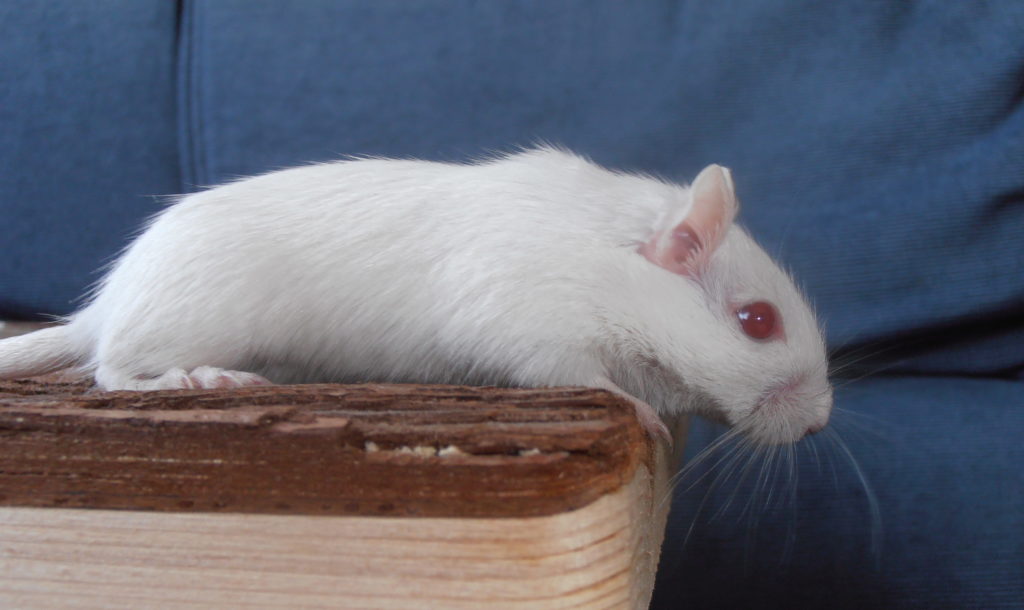
Argente Golden is an unmistakable colour in the gerbil world due to its dark, bold ginger coat color. When they are standing on all fours, you can hardly see their white tummy – just their bold color. Beautiful.
These colors are the exact genetic pairs of the silvers group which follow the same colour and genetic patterns.
Argente Golden is paired with Lilac, Argente Fawn to Sapphire and Argente Cream pairs with Dove to complete the set. All the Argente colors are shown in one class together at gerbil shows, but the silvers could be split in to just a Lilac class and a Dove class (darkest silver and lightest silver).
Pink Eyes in the population:
The gene that creates the ginger colour – the Pink Eye gene – works by diluting all the pigment-forming cells in a growing embryo – stopping all the black colors from forming.
An Agouti gerbil hair is made up of three sections – the third closest to the body is grey/silver, the middle section is ginger and the tip of the hair is black. All gerbil colours are made by the genes changing the proportion or amount of these three colors. And the Pink Eye gene removes all the black.
So in an Argente gerbil, this gene has the effect of removing all the black tips from the Agouti hairs – leaving the gerbils hair two-thirds ginger (a ginger-looking gerbil). However, it doesn’t affect the silver undercoat – that stays right there – and you can see this clearly on an Argente by simply parting the fur.
Argente even means ‘silvering’ in its true sense – perhaps this name would have been better suited for the twin group containing the Lilacs and Sapphires?
The actions of this gene, however, is also associated with poor eyesight as these gerbils now have no protection from the sun and you can see straight into the blood vessels and tissues – hence the pink colour. The black pigment in the iris blocks out the harmful effects of the sun – but it isn’t there in gerbils with pink, ruby and red eyes, so damage occurs at every exposure.
As a result, over time the effects of sunlight will damage some of the delicate tissues in the eyes which are now unprotected, with reports of the animals ending up blinded in old age (not a problem for gerbils though so most people prebably won’t even notice the difference).
I’m not sure it IS Argente Golden yet?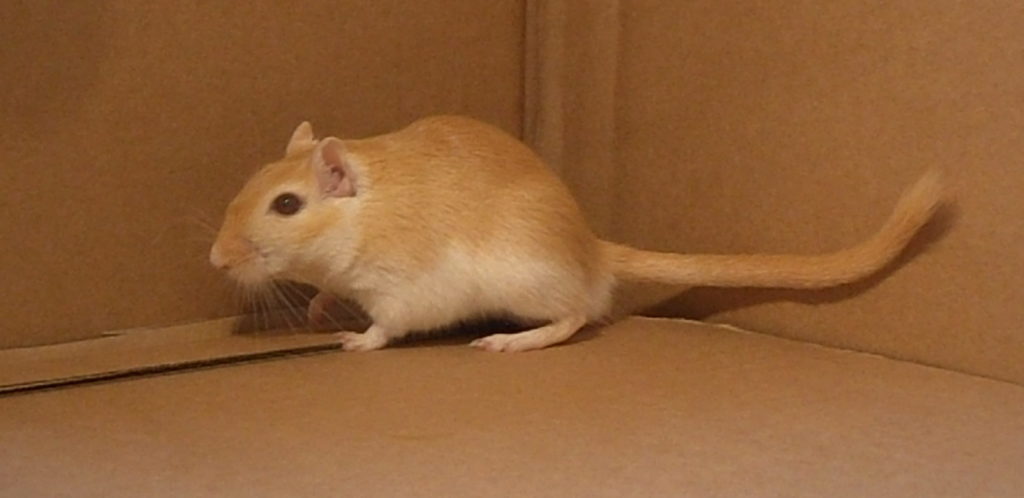
There are a few other colors that can be mistaken for an adult Argente Golden on first glance, but they all have their tell-tale signs to tell them apart with: they are Yellow Fox aka Red-Eyed Honey (REH) and Red Fox aka Saffron.
Yellow Fox – Red-Eyed Honey – (image top right) – These gerbils are also bright ginger in colour and they too have a white tummy – but there is more. The [ee] group of gerbil colors have what is termed a ‘higher demarcation line’ than those gerbils without the [ee] combination of genes.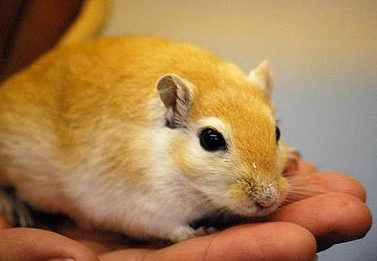
Basically this means that the line on their side between their body colour (ginger) and their tummy colour (white) is higher up on their sides – like when the tide is in.
Added to this rise in the white section, there is more white under the neck and up towards the eyes – and often a white or paler circle around the entire eye. (see Dark-Eyed Honey image right)
This can lead to the Yellow Fox-REH being described as a ‘ginger & white’ gerbil, whereas an Argente gerbil is usually described as a ‘ginger gerbil with a white tummy’ as the white is much less visible.
If still in doubt – rub the hair on the body backwards.
As stated above, we already know that an Argente gerbil will have a silver undercoat. The Yellow Fox-REH doesn’t have this silver undercoat as its gene combination of [ee] is is known as the ‘extension of yellow’ which basically means that its ginger section of hairs is extended all the way to the skin – covering over all the silver hairs.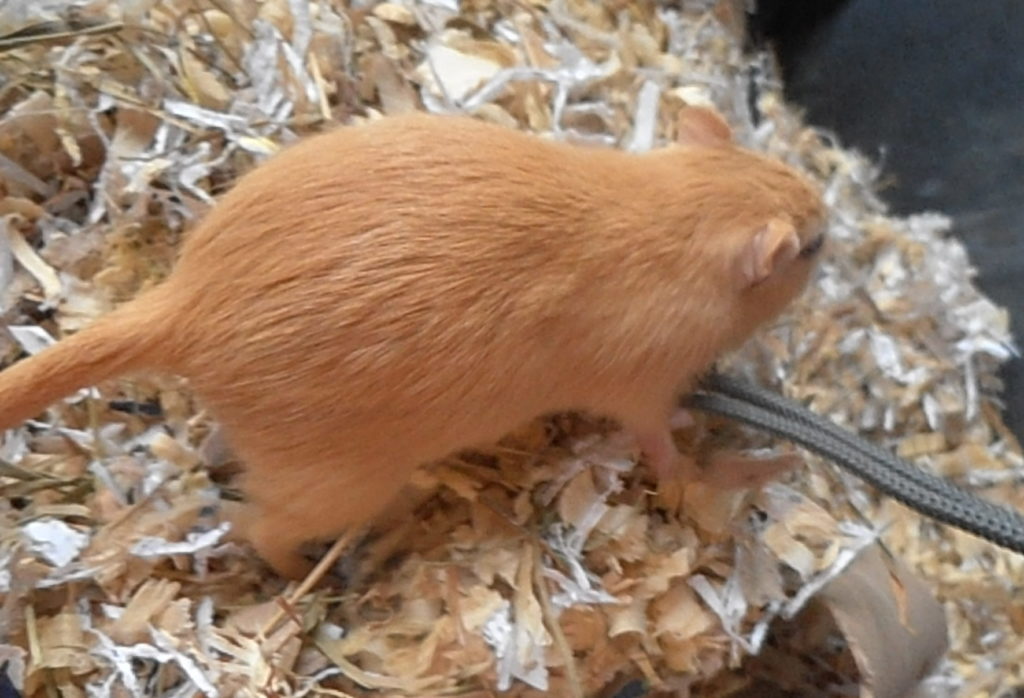
Red Fox-Saffron – The Red Fox or Saffron gerbil color is the exact genetic pair of the Yellow Fox or Red-Eyed Honey on the self side – so no white tummy. Easy to tell apart when un-spotted – (see image right).
When the Saffron is spotted this can be harder to see at first glance – so you have to see the tummy clearly (as a white belly on a spotted gerbil will always be smaller then a proper white tummy due to genetics) and you also need to look you for the eye rings – Argente don’t have circles around their eyes like Honeys and Foxes do (remember the Dark-Eyed Honey picture above).
Easiest thing though – as explain above – check the undercoat. Saffrons – like their colour twin REH – don’t have silver in their coat whe nyou part the hair.
You have Argente Golden gerbils you want to Breed?
Due to the prevalence of all the dominant genes needed to create an Argente gerbil, this color is one of the most commonly gerbil colors in litters after Agouti and Black.
However, it can be hard to get an Argente Golden pup in particular from random genes due to the prevalence of the chinchilla medium gene (which everyone seems to want to breed into their lines).
Genetics-wise, the main genes for a Argente Golden gerbil are quite ‘strong’ (strong in this instance means prevalent and dominant), so if you mate an Argente Golden gerbil to any other non-colorpoint gerbil, you will most likely get Argente Golden pups in the mix.
You want Argente Golden Pups?
There are loads of different ways to get Argente Golden pups in you litters depending on the gerbils you already have in the mix – or the gerbils you can go an buy from a local breeder.
If you want 100% Argente Golden pups you would need two Argente Golden parents – this way you can exclude all colorpoint genes and breed true = Argente Golden + Argente Golden – any recessives = 100% Argente Golden.
However if you don’t already have two, to get a large percentage of them in your litter, you would need to do one or all of the following things:
Only breed gerbils on the Agouti side
Always try to breed only agouti-based colours together. Argente can’t be formed without at least one Agouti gene available – and by having 2 Agouti genes each you could increase your chances of getting Argente Golden pups right there and into future litters.
Only breed gerbils with red/pink eyes (which are not white)
Breeding only pink-eyed gerbils (either A* or aa) means you will be eliminating all the dark-eyed colors (Agouti, Dark-Eyed Honey, etc). This doubles the chances of you getting Argente Golden pups. Breeding an Argente Golden to a Lilac would be perfect for your needs.
However, be careful not to use two gerbils with the same sets of recessives – as otherwise you will only get pups with those (i.e. don’t breed two Yellow Foxes-REHs together, or a Yellow Fox-REH and an Apricot as all the pups will be pink-eyed [ee] gerbils = no Argente Golden).
Avoid all colorpoint colours completely (including PEWs)
By avoiding any gerbils with known or suspected colorpoint genes – you are increasing your chances of making Argente Golden pups – as argentes don’t have or carry a colorpoint gene themselves (if they did, they would be another color instead).
PEWs are actually colorpoints – as are Himalayans – which will both ruin your chances of getting Argente Golden right there before you have even started – remember Argente Golden needs to be [CC].
However, there are also a few white or light cream gerbil colors with pink/red/ruby eyes that aren’t colorpoint that you could use (Apricot and White-Bellied Cream) – but unless you can be 100% sure of what these look like – don’t use them.
Don’t worry though if you can’t get any of the above though. Using colorpoint, dark-eyed or self-based gerbils in your breeding program won’t prevent you from ever getting Argente Golden pups – they will just lower the numbers of those color pups you will get on average.
I still get the odd Argente Golden pups in a Rainbow Litter, but they are few and far between.
Don’t have Argente Golden gerbils – but want them?
If you don’t have any Argente Golden gerbils of your own but actually do want them – you could try one of the following plans to get them…
1) Breed any red-eyed agouti-based gerbil with a Golden Agouti ( – best)
2) Breed any 2 red-eyed agouti-based gerbils (who don’t share genes) together ( – good)
3) Breed any red-eyed agouti-based gerbil with a Lilac ( – could be good)
These three options are most likely to throw up the right gene combinations for getting an Argente – and hopefully an Argente Golden. Like most breeding though – it can sometimes take more than one generation if you are working with unknown genes as everything is guesswork.
The above ideas just offer the best way to pull out a specific gene if you don’t know whether or not it is there in the first place.
Also, by limiting the genes for other colors in these mixes – you are MORE likely to get an Argente Golden – if it is possible. Gerbils only have an average of 5 pups per litter, so the likelihood of the color you want coming up is directly related to how many extra genes (those not needed to create the color you actually want) that you put in the mix. (See selective Argente litter image below – bascially all other genes not present in parents.)
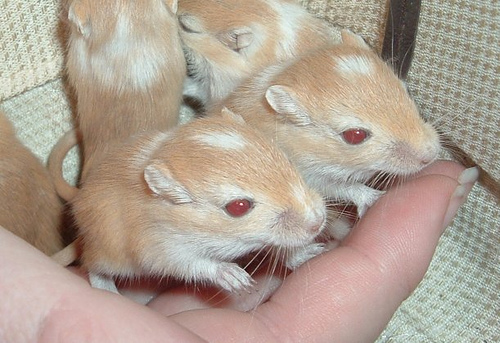
Don’t want Argente Golden pups in your litters?
There are several ways you can be sure of NOT getting Argente Golden pups in your litter:
Using a pair of gerbils which both carry the same recessive genes
This would mean something like breeding 2 [ee] gerbils together (like a REH and and DEH; or a White-Bellied Cream and a Red-Eyed Silver Nutmeg). If both parents do not carry the dominant [E] version of this gene – you can’t ever get Argente Golden pups from that pairing even if you use both [pp] parents – you would ALWAYS get only [ee] young.
Same goes for breeding 2 underwhite gerbils together; an Argente Golden gerbil can’t have 2 recessive genes at that point so you will never get one in your litters.
Only breeding colorpoint colours
This will ALWAYS exclude Argente Golden gerbils – they can’t have any colorpoint genes in their genotype.
Colorpoints used can be either agouti-based or self-based – it doesn’t matter. This is where you can actually use PEWs in your breeding program.
Breeding two gerbils that have double dominants in the [P] locus
If you breed together gerbils who don’t have a recessive copy of the defining gene of an Argente Golden – the pink eye gene – then you can’t ever get one. (like the Nutmeg pup image below)
Breeding together two gerbils that both have the genes [PP] means that their pups can only ever have dark-eyed pups and they can never pass on pink eyes, ever.
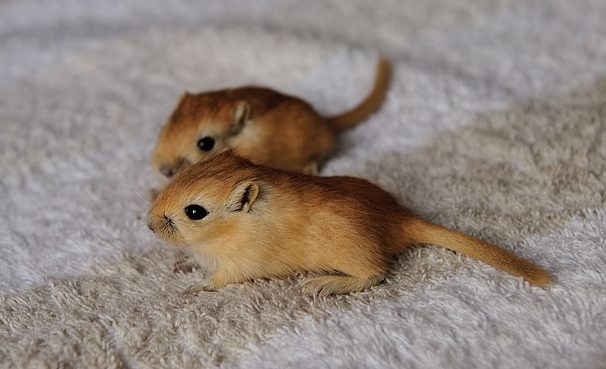
Using either of these techniques above also limits the number of other colours you will get overall too, but once you start breeding and seeing the pups, you can write down your expressed genes and work out who is best for what further down your line.
For more information about Breeding for Color please do read on…